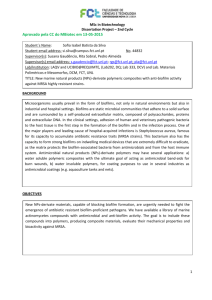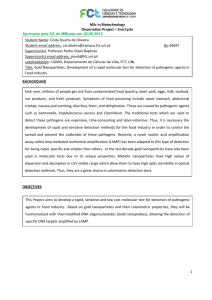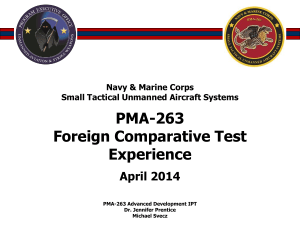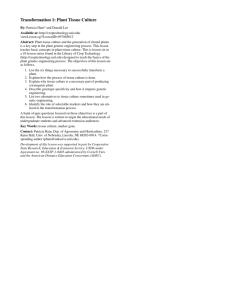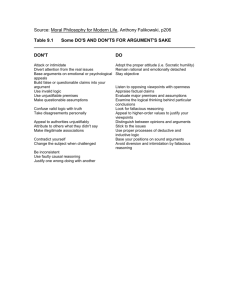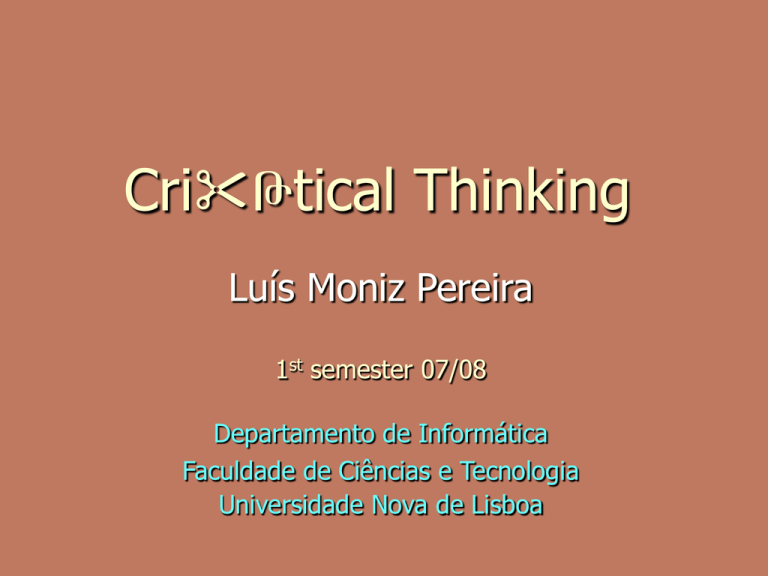
CriԹtical Thinking
Luís Moniz Pereira
1st semester 07/08
Departamento de Informática
Faculdade de Ciências e Tecnologia
Universidade Nova de Lisboa
Critical thinking in the Portuguese
curricula
The teaching of critical thinking skills in Portugal is rare
in science and engineering programmes. To our
knowledge, there is no specific Critical Thinking (CT)
course in Higher Education, in any field. The one
reported here is first of its kind.
The course takes place at Universidade Nova de
Lisboa, and began in September 2006. Detailed
information, including slides and other documentation
in English, can be found on the web page
http://ssdi.di.fct.unl.pt/lei/pc/
Critical thinking in the Portuguese
curricula
CT was introduced in 2006 as a compulsory course in
the 3rd semester of Informatics Engineering, formatted
according to a 3-year Bologna 1st cycle, as part of its
recommendations for more soft skills in higher
education. 97 students enrolled in 06 and 196 in 07.
This CT course is preceded by a generalist and
mandatory “Expression and Communication” course in
their 1st year, and is followed, in the 2nd cycle (for those
who continue) by an obligatory course on “Scientific and
Technical Communication”.
The relevance of CT for engineering
education
Though our CT course follows a fairly standard
approach, it is innovative in emphasizing the stance of
the specialized producer of scientific and technical
information, not just that of the layman information
consumer.
CT skills are essential for good and apt decision making
and the understanding of problematic issues.
It is most important for engineering professionals,
expected to make decisions, solve technical problems,
face ethical balances, employ best practices, report and
document findings and products, and act in a consultant
capacity.
The relevance of CT for engineering
education
A deeper understanding of the epistemological,
philosophical, and methodological foundations of
science is also important. And not just for those
intending to pursue a research or teaching career.
Ironically, engineering and science training can
discourage CT by presenting the student only with well
established theories, received wisdom, and best
practices, not necessarily inviting a critical attitude.
This may leave them unprepared to face real life
situations, where uncertain, fuzzy, unreliable, or even
misleading information can affect the decision process.
The relevance of CT for engineering
education
Though students are prepared in their scientific field, they
are hesitant and have difficulty in criticizing non-scientific
claims in their daily lives.
In practical sessions of this CT course, students are asked
to discuss subjects such as astrology, miracles, or spirit
communication. Many initially argue in favour of these
beliefs, simply based on the absence of negative
evidence.
While no engineering student would argue in favour of a
technical claim in their field based on such weak reasons,
they seem unaware of the importance of positive
evidence to support a claim, outside their area of
expertise.
The relevance of CT for engineering
education
CT is essential for effective scientific and technical
communication. In addition to skills to assess claims and
data, it is important for engineering students to develop
the skills to criticise their own assumptions and
inferences, and how they communicate and argue their
own knowledge.
These important skills for the engineering professional
are rarely part of the regular technical courses, where the
students are graded rather by their performance. The
examinations focus on the application of technical
knowledge, not on its actual communication.
The relevance of CT for engineering
education
Thus our focus on two aspects of CT:
– As consumers of information, requiring the skills to
assess claims and inferences critically;
– As producers of technical information, with specific
training to question assumptions, to put checks on
reasoning, and to avoid fallacies.
We designed the course with two major goals in mind:
– To improve the student’s ability to analyse claims and
information critically;
– To teach students to present results and technical
information in a correct manner.
The Critical Thinking course
The course is taught by alternating 2-hour lectures
presenting the subject matter to all students, with 2hour practical sessions where a smaller number of
students (approx. 30) have the opportunity to discuss
subjects and practice with exercises.
Students are expected to spend an additional 6 hours
per week on individual study and practical exercises.
All sessions are recorded on digital audio files made
available in the course’s web site, so students can
review the sessions and hear their own contributions to
discussions.
The Critical Thinking course
Evaluation in 06 was split into theoretical and practical
components. The practical one consists of 4 exercises and 2
essays, all individual. Exercises are up to 1K characters, each
focusing on a specific aspect of CT, such as building an
argument, analysing a scientific theory, or making a decision
under uncertainty.
The essays are at most 5K characters, and each covers a broader
part of the course. The first is on some objective issue, requiring
students to build an argument, analyse competing hypotheses,
and assess the reliability of sources. Last time it was an analysis
of conspiracy theories about the fall of the Twin Towers in NY.
The Critical Thinking course
The final essay is on decisions involving both objective
data and subjective values. Students can choose the
theme for the second essay, with recommended
subjects like environmental policies, immigration,
abortion, copyright laws, and such.
The goal is to have the student make a policy decision
in the face of uncertainty, distinguish objective aspects
from the value judgements, and present and defend
such decision in a structured argument.
The Critical Thinking course
Active participation in the practical sessions is taken into
account for evaluation purposes. The practical
component accounts for 40% of the overall grade.
The theoretical component of the evaluation is a 2-hour
long written exam, requiring a broad view of CT, where
each student will choose 2 out of 4 topics provided,
form an opinion, and present it as a written argument.
It accounts for 60% of the grade.
The CT curriculum
The curriculum can be divided into 2 stages. The first
focuses on the analysis of objective issues, and the
second addresses matters involving decision and value
judgements.
The first stage covers, in order, the structure and logic
of arguments, abduction and the formulation of
explanations, properties of good explanations,
designing experiments to test alternatives, the analysis
of scientific models, and epistemological issues.
The CT curriculum
The second stage covers the assessment of statistical
data, decision as satisfaction and optimisation, the
consideration of consequences, alternatives and
opportunity costs, and finding omitted information.
There is also an introduction to ethical concepts, as
they play an important role in decision making, but the
focus is on the objective aspects of decision.
Results
The 06 course has shown that students start poorly
prepared for creating sound arguments, with most
resorting to rhetorical tricks and arguments from
personal opinion, instead of correctly identifying the
important aspects of the problem.
However, our experience so far indicates that students
quickly grasp the important aspects, and the utmost
relevance of critical thinking. There is a noticeable
improvement along the semester in students’ capacity
to analyse different subjects.
Results
Student reaction has been positive, with most students
showing they are interested in the subject, and many
participating in the discussions.
Also, a few students for whom this course is not
available have been coming to the discussion classes,
even though they are not enrolled. This suggests a
potential for the expansion of this course to students
outside Informatics Engineering.
Main Bibliography
Alec Fisher, 2001, Critical Thinking - an introduction,
Cambridge U.P.
Jonathan Baron, 2000, Thinking and Deciding,
Cambridge U.P., 3rd ed.
Ronald Griere, 1997, Understanding Scientific Reasoning,
Harcourt Brace, 4th ed.
Douglas Walton, 2004, Abductive Reasoning,
The University of Alabama Press.
M. Neil Browne, Stuart M. Keeley, 2004, Asking the Right
Questions, Pearson Prentice Hall, 7th ed.
References
Baron, J. 2000, Thinking and Deciding, Cambridge U.P., 3rd edition.
Blackmore, S. 1991, “Near-Death Experiences: In or out of the body?“. Skeptical Inquirer
1991, 16, 34-45.
Browne, M. N. and Keeley, S. M. 2004, Asking the Right Questions, Pearson Prentice
Hall, 7th edition.
Caplinger, M. 1995. “Life on Mars”, at http://www.msss.com/http/ps/life/life.html
Fisher, A. 2001, Critical Thinking - an introduction, Cambridge U.P.
Giere, R.N. 1997, Understanding Scientific Reasoning, Harcourt Brace, 4th edition.
Newport, J.F. 2005. “A Theory That Accounts For the Occurrence of All NDEs”,
at http://www.near-death.com/experiences/articles006.html
Pereira, L. M. and Krippahl, L. 2007. “On Teaching Critical Thinking to Engineering
Students”, Procs. The 13th Intl. Conf. on Thinking, Norrköping, Sweden.
Schick, T. and Vaughn L. 2004, How to Think about Weird Things, McGraw Hill
Thompson, A. 2002, Critical Thinking - a practical introduction. 2nd ed. Routledge.
Incidence
A course with “soft skills” incidence.
It has general relevance for any scientific area
(and in particular for that of Informatics)
because of the strong liaison with logic for the
analysis of arguments, of hypothesis, and for
problem specification and problem solving.
Objectives – “To know”
Correctly interpret experiments and experimental
data.
Infer conclusions from data and correctly judge the
credibility of sources.
Identify incorrect inferences and solve
contradictions. Debugging.
Argue for and identify compromise solutions.
Resolve ambiguities and evaluate alternatives.
Understand logical and causal explanations.
Objectives – “To do”
Create valid and structured arguments that
manage alternative hypotheses in context.
Express ideas and their logical support.
Correctly describe experiments, results and
conclusions.
Elaborate testable hypothetical explanations.
Propose and interpret causal explanations and
compare alternatives.
Objectives – “Soft Skills”
Communication, debate, and precision of
expression.
Critical thinking and information gathering.
Disciplined reasoning.
Objective evaluation of facts and arguments.
Ability to decide over trade-off situations
involving utility values.
Student effort - ECTS
Hours per credit
The usual number of weeks per semester is 14
Theory sessions
28
Hours per
week
Weeks
2
14
28
2
14
28
Hours
Theoretical-practical sessions
Practical and lab sessions
Seminars
Internship
Tutorial guidance
4
Other
10
Projects and essays
30
Study
60
Assessment
6
Total hours
166
ECTS
6
Functioning - Lecturers
Lecturers
– Theory :
Prof. Cat. Luís Moniz Pereira
lmp@di.fct.unl.pt
http://centria.di.fct.unl.pt/~lmp/
room 2.47 Ed II, ext. 10717
student guidance: Thu 11:00–12:00
– Practice :
Prof. Aux. Ludwig Krippahl (4 groups)
ludi@di.fct.unl.pt
http://centria.di.fct.unl.pt/~ludi/
room 2.41 Ed II, ext. 10765
student guidance: Thu 10:00-12:00
Prof. Aux. Ana Rita Canário (2 groups)
arsc@fct.unl.pt
room 2.49 Ed I, ext. 10504
student guidance: Tue 10:00-12:00
Schedule
Theory
Thursday, 16:00-18:00, 1D Ed.VII
P1
Friday, 9:00-11:00, 3.9 Ed.VIII
P2
Friday, 11:00-13:00, 3.9 Ed.VIII
P3
Friday, 14:00-16:00, 3.3 Ed.VIII
P4
Friday, 9:00-11:00, 3.3 Ed.VIII
P5
Friday, 11:00-13:00, 3.3 Ed.VIII
P6
Thursday, 8:00-10:00, 3.5 Ed.VII
Functioning – CT page
Site http://ssdi.di.fct.unl.pt/lei/pc/ with:
– Objectives, programme, assessment, etc
– Summaries of theory and practical sessions
– Slides and digital sound recording of each session
– Documentation, exercises, evaluation results
– External links
– Software
– Email distribution list, subscribe!
https://mail.di.fct.unl.pt/mailman/listinfo/lei-pc/
– Mail for sending work done: practicaspc@di.fct.unl.pt
Functioning – Assessment 1
The pratical component is worth 40% of the
overall course grade and consists of:
– Continuous evaluation of students by the teacher, in
the pratical discussion sessions.
– Four individual fiches with about 100 words and about
4 hours of effort in reading and preparation.
– One individual essay with about 500 words and 15
hours of effort in reading and preparation.
Only those students with a practical grade of 10
or more are admitted to the final exam
("frequência"). Each student must be present at,
at least, 9 practical sessions.
Functioning – Assessment 2
Those students having obtained a practical grade of 10 or
more in academic year 2006/07 will keep that grade if they
do not register for practical sessions in 2007/08.
Alternatively, they can register in a practical class and do
the practical component normally.
The final exam is worth 60% of the final grade. It is a 2
hour written exam with approximately four essay questions
with a one page answer each. Students will have to
interpret texts and elaborate structured and clear answers
to the problems, and will be encouraged to write several
drafts before submitting an answer.
There is no obligatory presence in theory lectures.
Programme - 1
Argument structure
– Formal logic structure.
– Validity requirements, ambiguity.
Fallacies and errors in reasoning
– Reasoning errors. Removing contradictions.
– Fallacious use of evidence.
– Language mistakes and personal bias.
Programme - 2
Critical
Evaluation
– Evaluating personal experiences.
– Belief and knowledge.
– Statements and the burden of proof.
Programme - 3
Scientific Reasoning
–
–
–
–
The importance of testability. Explanatory preferences.
Epistemology and the evaluation of theoretical models.
Causal and statistical hypotheses.
Independent confirmation and peer-review.
Communication and information sources
Decision making and trade-offs
– Evaluating and comparing alternatives.
– Ethics.
Two sides of the coin
Critical thinking has two sides to it:
- That of the consumer of information.
- That of the producer.
Often, the stress is put just on the general public,
viewed as the critical consumer.
Here, we shall stress the critical producer side too:
university students are trained to be producers of
knowledge, activities, decisions and designs, and
hence should strive to be self-critical producers.

